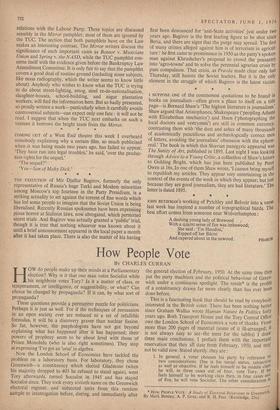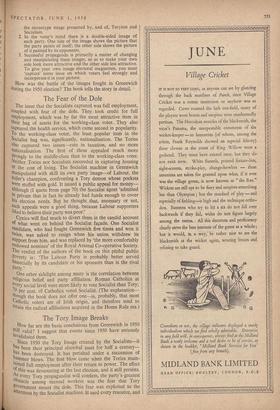How People Vote
BY CHARLES CURRAN HOW do people make up their minds at a Parliamentary election? Why is it that one man votes Socialist while his neighbour votes Tory? Is it a matter of class, or temperament, or intelligence, or suggestibility, or what? Can choice be changed by propaganda? If it can, by what sort of propaganda?
These questions provide a permanent puzzle for politicians. Perhaps it is just as well. For if the techniques of persuasion in an open society ever are reduced to a set of infallible formulas, it will be a discovery graver than nuclear fission. So far, however, the psephologists have not got beyond explaining what has happened after it has happened; their powers of prophecy, seem to be about level with those of Prince. Monolulu (who is also right sometimes). They stop at expressing 'I've got an 'orse' in algebra.
Now the London School of Economics have tackled the problem on a laboratory basis. For laboratory, they chose Greenwich—a constituency Which elected Gladstone (when his majority dropped to 403 he refused to stand again), went Tory afterwards. turned Socialist in 1945 and has stayed Socialist since. They took every sixtieth name on the Greenwich electoral ' register, and subjected units from this random sample to interrogation before, during, and immediately after the general election of February, 1950. At ,the same time they put the party machines and the political behaviour of Green- wich under a continuous spotlight. The result* is the profile of a constituency drawn far more clearly than has ever been done before.
This is a fascinating book that should be read by everybody interested in the British voter. There has been nothing better since Graham Wallas wrote Human Nature In Politics forty years ago. Both Transport House and the Tory Central Office owe the London School of Economics a vote of thanks. FroM. more than 200 pages of material (some of it ill-arranged; It is not always easy to see the trees for the tables) I draw three main conclusions. I preface them with the important reservation- that they all date from February, 1950, and may not be valid now. Stated shortly. they are : 1. In general, a voter chooses his party by reference to two considerations. One is his social status, subjective as well as objective. If he feels himself to be middle class he will, in three cases out, of four, vote Tory. if he feels himself to be working class then, in four cases out of five, he will vote Socialist. The other consideration is * How PEOPLE VOTE: A Study of Electoral Behaviour in Greenwich. By Mark Benney, A. P. Gray, and R. H. Pear. (Routledge, 25s.)
the stereotype image presented by, and of, Toryism and Socialism.
2. In the voter's mind there is a double-sided image of each party. One side of the image shows the picture that the party paints of itself; the other side shows the picture of it painted by its opponents.
3. Successful propaganda is primarily a matter of changing and manipulating these images, so as to make your own side look more attractive and the other side less attractive. To give your own image electoral magnetism, you must `capture' some issue on which voters feel strongly and incorporate it in your picture.
How was the battle of the images fought in Greenwich during the 1950 election? The book tells the story in detail.



































 Previous page
Previous page